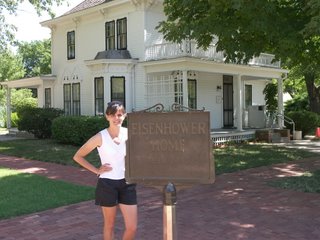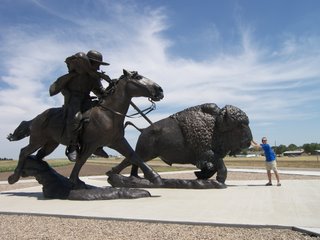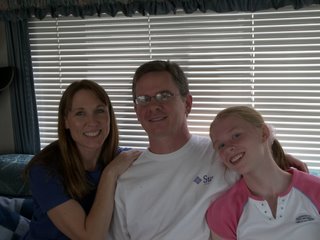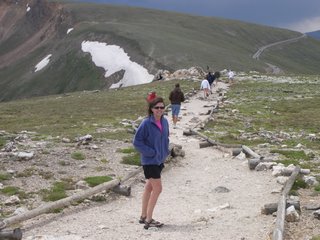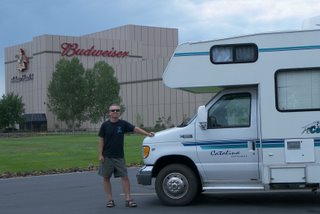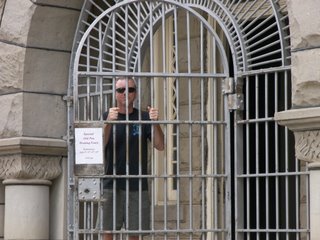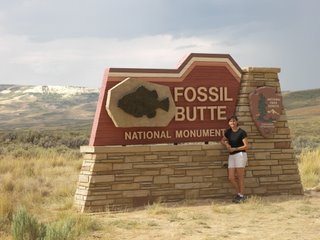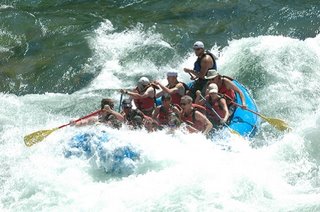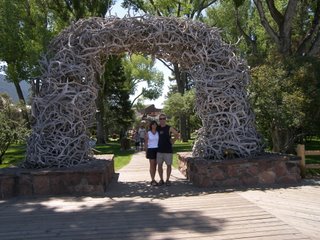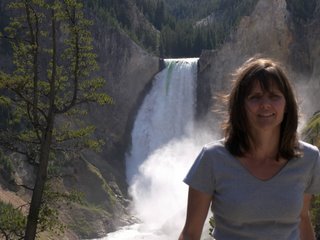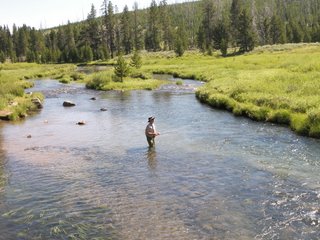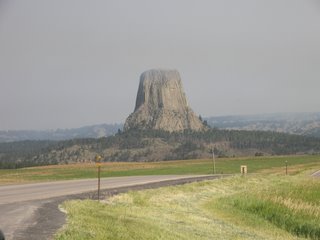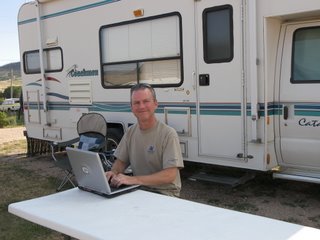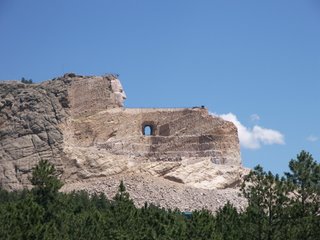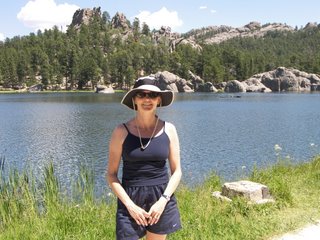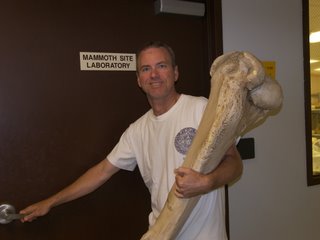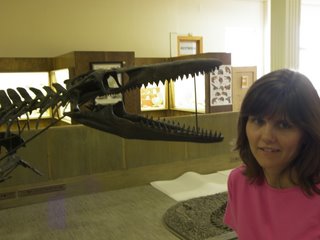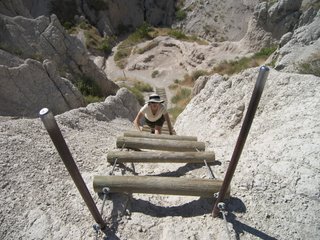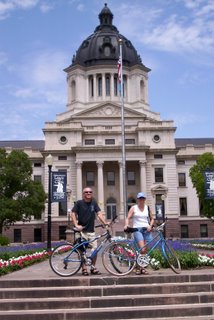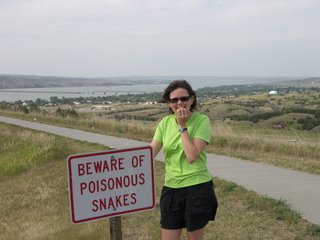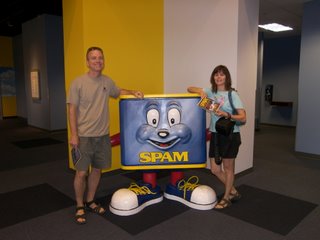July 19, 2006
This morning we want to see Old Faithful and the southwest side of the park and hopefully stay in Grand Teton Park to the south tonight. Near our campsite is the West Thumb geyser basin. We hike the circular boardwalk that straddles West Thumb, a large circular cove off Lake Yellowstone. One of the signs says that this cove was formed as the result of a small volcanic eruption about 150,000 years ago. Hot water and steam is gushing out of the ground all over this small area, even in the lake itself. There is one spot about 10 feet offshore called Fishing Cone, where if you pull your boat alongside, you can catch a trout on one side and on the other, dip it into the hot spring cone to cook it.

We head on towards Old Faithful. I am hoping to get lucky and arrive just before Old Faithful does its thing, so we can see it and move on. We have seen enough geothermal activity. We arrive at the Old Faithful parking lot and we immediately see it is the largest so far. Old Faithful is probably the biggest draw at Yellowstone and you probably have a lot of tourists waiting around till it goes off. Once we park, we head straight to Old Faithful. I don’t see a clock anywhere, but fortunately a ranger soon walks up and announces to the crowd that Old Faithful is still 45 minutes off, but that the indicators are showing that the Beehive geyser will erupt in 5-10 minutes. We quickly hike the few hundred yards to its location. On the way I am thinking that the Park Service has installed some temperature sensors in the geysers to monitor and predict eruptions. Less than a minute after we arrive, it erupts. Wow!! It is cool. Out of a two foot wide cone shoots a massive fire hose of steam and water. Not only does it shoot water almost two hundred feet in the air, it continues to do so for at least 5 minutes. I am hooked on geysers now. I want to see more. We head to the nearby Visitor Center and along the way I am telling Aimee how lucky we were to arrive just as Beehive went off. Any delay and we would have missed it.
At the Visitor Center, we find they have a board with the time estimates for six geysers. Beehive isn’t one of them. Looking at the site map, I see that Old Faithful is on the Upper Geyser Basin, which has at least several dozen geysers. This is a very large area. I write down the schedule of the six but we have a big timing problem. Aside from Old Faithful, the others don’t go off but once, maybe twice a day, and their estimates are plus or minus 90 minutes. If we have to wait around three hours to see each geyser explode, we are going to be here at least another day. Old Faithful is set to go off in 15 minutes, so we stroll back out to Old Faithful and find seats on the bench and wait. Old Faithful erupts five minutes early. It is nice but nowhere near the excitement of Beehive. I find that Old Faithful is not the biggest, highest or most predictable; it just happens to go off the most frequently (not quite hourly) so it pleases the quick tourist.
The next scheduled eruption isn’t for another couple hours so we head to nearby Old Faithful Inn for lunch. I have seen the lobby on the Travel Channel and it is just as pretty. The five-story lobby is totally constructed of varnished pine logs with a massive fireplace in the center. We dine leisurely in the restaurant just off the lobby.
After lunch we head back out to the basin and stroll the boardwalk. This area has geysers of every name and description. This Upper basin is a 2-mile long rectangular white chalky strip with a large stream running right down the center, called the Firehole River. The interpretative sign for Beehive explains that it and a couple others have secondary spouts alongside that are tied into the same geothermal plumbing. So when Beehive gets close to erupting, the tiny geyser next to it begins spitting providing a natural indicator for Beehive’s next eruption. So much for Park Ranger temperature sensors, Mother Nature’s way is much more elegant.
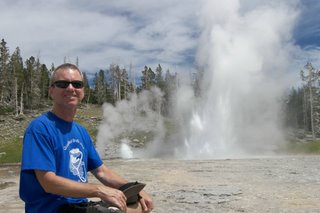
Old Faithful and Beehive are both cone geysers shooting water straight up from a rock nozzle. We come next to Grand Geyser, supposedly the largest predictable geyser. Grand is a fountain geyser, meaning it spews water from a pool in many directions. It is set to go off in another 30 minutes at 2:00pm. I would like to see the difference so we make plans to walk a little farther down and come back shortly before 2:00pm. Just as we turn to leave, Grand takes off. Luck is with us again today. Grand shoots a bouquet of water up in large pulses, like rockets in a fourth of July fireworks display. It continues for fifteen solid minutes. A river of water soon begins to drain underneath our bench headed I am sure to the Firehole River.
As we continue on down the boardwalk, we are finding that the majority of geysers are very unpredictable and may not erupt for years. One, the Giant geyser has a very large cone. When it is ready it spews water for ninety minutes, almost a million gallons of water. Another, the Castle geyser has a cone the size of a kids play fort. Because the cones are made from minerals left behind by the geyser water spray, they are an indicator of the geyser’s age. Castle is ancient; Old Faithful is just a baby at a few hundred years.

Shortly after Grand, we come to the turnout for Riverside geyser. The map explains that its notoriety is that it sits on the bank of the Firehole River and shoots water out in an angle over the river. That would be nice to see. It is set to go off in 20 minutes at 2:25pm. I tell Aimee that the end of the boardwalk is just ahead. Lets quickly go see the Morning Glory Pool at the end and come back to see Riverside. Just as we do, Riverside starts erupting and I run down the path to get a look. I didn’t need to run, as Riverside spews for twenty minutes and we are able to take as many pics as we like.
Well I am feeling very blessed today. In just a few hours, we have toured the main geyser area and have seen four major geysers explode, three of them almost on cue of our arrival. Aimee must be my good luck charm. I will have to keep her awhile. We are finally tiring of geysers, so we head to the exit. On the way we stop for ice cream at the Inn. It has been a hot steamy day. It is later than we thought, so we decide to stay in the park again. We head to nearby Grant Village, the campground closest to the Tetons. Being tired I don’t notice the “Full” sign at the campground entrance. No matter, this is our lucky day and we get a site due to a cancellation.
